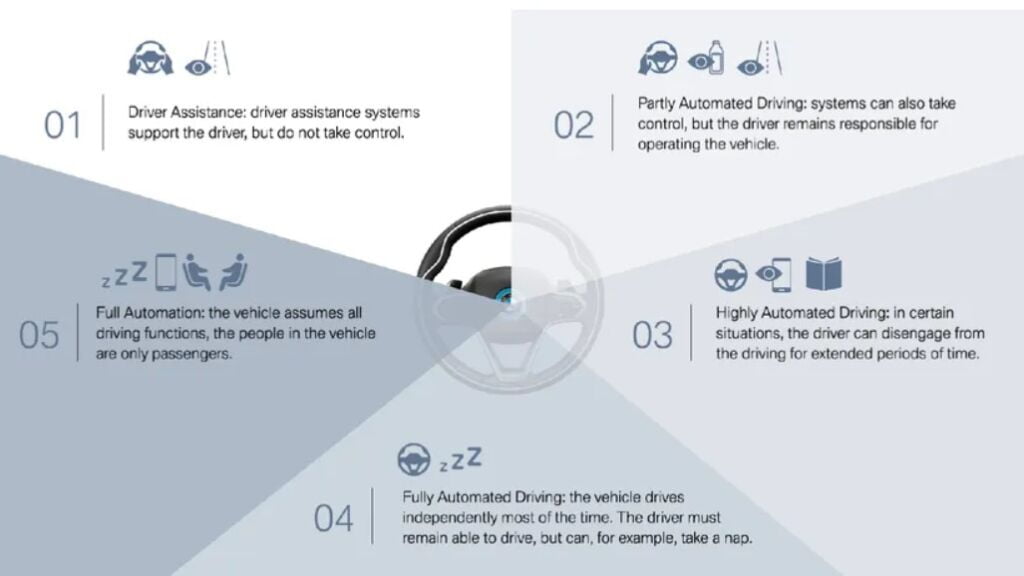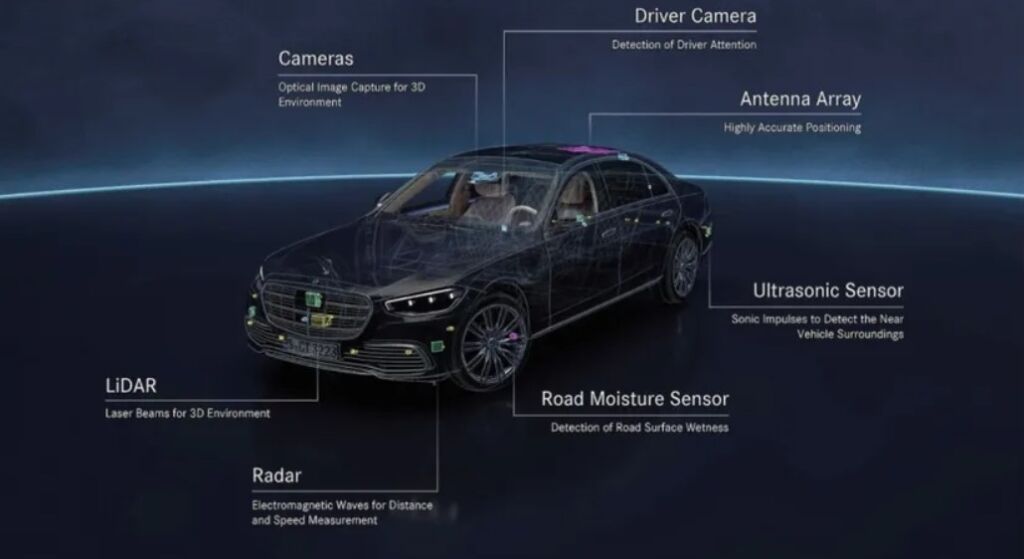Autonomous driving levels refer to the vehicle’s ability to operate without human intervention in different driving situations. From the most basic to the most advanced levels, these define the degree of autonomy they can achieve and are a key indicator of how technology is changing the future of transportation.
Autonomous vehicles in a nutshell are defined as a “computer controlled car that drives itself”. In other words, human drivers are never required to take control, instead relying on sensors and software to control, navigate and steer the vehicle.
Autonomous driving systems sense the environment around a car, for example, through a series of sensors and then take pre-programmed actions based on what those detect.
Ultrasonic, radar, light detection and ranging (LiDAR) sensors and other sensors are placed on the vehicle body to create as complete a picture of the surrounding environment as possible. That information allows autonomous vehicles to do things like parallel park or detect water or road construction and adjust accordingly.
Automakers have been focusing their work and investment harder than ever on advanced safety systems and driver assistance technologies for the last decade and what is available today is different levels of autonomous driving. In this report you will learn what each level means and at what stage are some of the top companies of the moment such as Tesla.
What are autonomous driving levels?
Before they can hit the road, autonomous vehicles will first have to progress through 6 levels—or 5 if level 0 is removed—of driver-assistance technological advances.
To get industry, governments and society on the same page, the International Society of Automotive Engineers (SAE) defined a common language and standard (J3016) in its 2014 report titled ‘Taxonomy and Definitions for Terms Related to On ‘ ( Automated driving systems for road motor vehicles).
The reality is that autonomous vehicles are categorized into various levels of autonomy ranging from 0 (I’m just a regular car) to 5 (I don’t need you to drive for me).

From 1 to 5: this is the meaning of each of the levels
SAE Level 0: no automation
The person behind the wheel steers, brakes, accelerates and manages traffic. Here there is little more to investigate because at this level belong the normal and current vehicles that everyone already knows.
SAE Level 1: Driver Assistance
Level 1 is the most basic type of autonomy and safety, where one element of the driving process is assumed in isolation, using data from sensors and cameras, but the driver remains in charge.
Here you can find adaptive cruise control and road keeping assist technology to help with the driver if they are tired, for example.
Adaptive Cruise Control will maintain a safe distance between you and the vehicle in front of you by using radar and/or cameras to automatically brake when traffic slows and resume speed when it clears.
Road Keeping Assist may also be present and assists in returning to the lane should the vehicle begin to drift out of it.
These technologies were introduced in the late 1990s at Mercedes-Benz , with its pioneering radar-managed cruise control, while Honda introduced road keeping assist on the 2008 Legend. These were the first steps toward developing a real autonomous vehicle.
SAE Level 2: partial automation
At this level, things get a bit more interesting. Although the driver must have their hands on the wheel and be ready to take control at a moment’s notice, Level 2 automation can help perform basic tasks.
The driver still needs to perform maneuvers, such as responding to traffic signals, changing lanes, and troubleshooting before hazards. Vehicles at this level are often equipped with advanced driver assistance systems (ADAS) that can take over steering, acceleration and braking in specific scenarios.
These systems are beneficial in times of intermittent traffic, as they maintain the distance between the person and the vehicle in front and, at the same time, provide steering assistance by centering the vehicle within the lane. Tesla Autopilot, Volvo Pilot Assist and Audi Traffic Jam Assist are some examples of Level 2 autonomous capabilities.
SAE Level 3: conditional automation
The progression from level 2 to level 3 is substantial from a technological standpoint but subtle, if not insignificant, from a human perspective.

The SAE calls level 3 ‘conditional automation’, which is a specific mode that handles all aspects of driving, but the driver must be ready to respond to a request for intervention.
Autonomous vehicles at this level are capable of driving themselves, but only under ideal conditions and with limitations , such as well-signposted roads limited to certain speeds. A human driver is still required to take over in the event road conditions drop below guidelines.
Some vehicles at this level have “environmental sensing” capabilities and can make decisions for themselves, such as speeding up to pass a slow vehicle. Audi’s A8 is a great example and has the ability to drive itself under certain circumstances.
SAE Level 4: high automation
At level 4, the vehicle’s autonomous driving system is fully capable of monitoring the driving environment and managing all driving functions for limited routes and conditions defined within its operational design (ODD).
The steering wheel and pedals remain at this level, but no human intervention or supervision is required, except under certain conditions, such as the type of road or geographical area, bad weather, and other unusual environments such as a construction site, for example.
The driver can manage all the driving tasks on the streets of a city and then become just another passenger when the vehicle enters a highway. Additionally, the vehicle can alert the driver that it is reaching its operating limits if those conditions require human intervention, such as heavy snow.
If the driver does not respond, the driver will automatically secure within the safety parameters specified by the brand, including slowing to a complete stop.
For example, here you could find the following brands and vehicles:
- NAVYA, a French company, is already building and selling Level 4 shuttles and cabins in the US that run entirely on electric power and can reach a top speed close to 90 km/h.
- Alphabet’s Waymo recently introduced a Level 4 autonomous taxi service in Arizona, where they had been testing self-driving cars, without a safety driver in the seat, for over a year and over 10 million miles.
- Canadian automotive supplier Magna has developed technology (MAX4) to enable Level 4 capabilities in highway and urban environments. They are working with Lyft to supply high-tech kits that make the vehicles autonomous.
- Volvo and Baidu recently announced a strategic partnership to jointly develop Tier 4 electric vehicles to serve the robotaxi market in China.
SAE Level 5: full automation
Vehicles at level 5 are fully autonomous, meaning a driver is not required to perform all driving tasks . Autonomous vehicles at this tier are not limited by zones or affected by weather.
Destination alone is the only requirement to get from point A to point B. In fact, vehicles in this category may not be equipped with steering wheels or accelerator/brake pedals. Passengers simply communicate with the vehicle using voice commands to regulate the air conditioning, make a call or change the station, for example.
Although the technology for a fully autonomous car exists today, it is still in the development stage . If this is combined with current regulations in Europe or the US and legal issues, the full-scale deployment of Tier 5 vehicles is still many years away.
Why is Tesla’s fully autonomous driving still at level 2?
Elon Musk has stated emphatically that his cars will be the first that can be bought that are completely controlled by themselves.
But long ago a series of emails surfaced between Tesla and the California Department of Motor Vehicles, admitting this capability is no more than level 2, when previously Elon Musk had claimed they would be close to level 5 by the end of 2021.
Tesla eventually stated that its technology is a Tier 2 semi-autonomous driving system, and it’s not even close to the more advanced Tier 3 or Tier 4 system already being developed and implemented by rival automakers.
Also Read: What Is ViveTool And How To Use It ?



